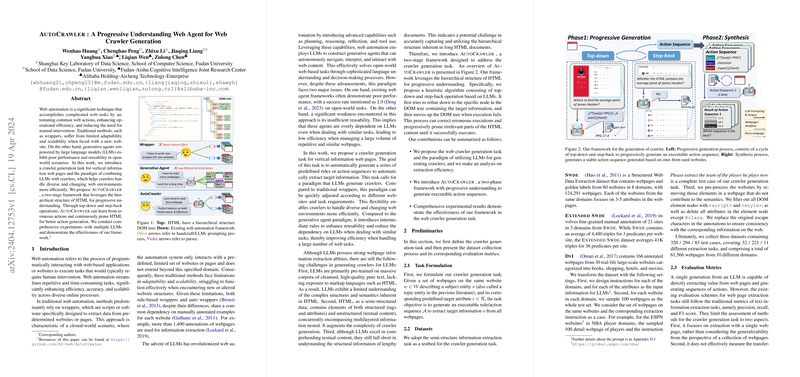Enhancing Web Automation Through AutoCrawler: A Two-Stage Crawler Generation Framework
Introduction to Enhanced Web Automation
The paper discusses the limitations of traditional web automation methodologies that rely heavily on wrappers and introduces a novel approach to this problem using LLMs. Traditional methods are often restricted to a predefined set of pages and fail to adapt when encountering new website structures. By leveraging LLMs, the authors aim to address these limitations and propose AutoCrawler, a two-stage crawler generation framework that combines the strengths of both LLMs and traditional crawling techniques to enhance adaptability and efficiency.
Crawler Generation Task Design
The paper presents a new task framework for crawler generation, particularly focusing on vertical information web pages. The task is structured to exploit LLMs for rule or action sequence generation, promising quicker adjustments and better performance across diverse web environments. This approach introduces intermediate rules that enhance the reusability of generated crawlers, reducing LLM dependency and improving operational efficiency on similar web tasks.
Challenges and Framework Description
Several challenges arise when integrating LLMs with web crawling tasks. Firstly, LLMs are typically trained on clean text and may struggle with the HTML's structured and semi-structured nature. Secondly, the hierarchical and nested nature of HTML poses significant interpretation challenges for LLMs, which traditionally excel in textual context but not in structural understanding.
In response to these challenges, AutoCrawler was developed as a two-stage framework that utilizes top-down and step-back operations to progressively refine the focus within the HTML content, thereby enhancing the accuracy of the crawler generation process. This method allows the framework to learn from errors and iteratively refine the crawler's actions.
Experimental Analysis and Results
Comprehensive experiments conducted across multiple datasets, including Swde and Extended Swde, demonstrate AutoCrawler's effectiveness. The framework significantly outperformed existing LLM-based methods in generating more precise and reusable crawler actions. The paper details the datasets and evaluation metrics used, emphasizing the extraction and executability of generated rules across different web pages.
Implications and Future Directions
The introduction of AutoCrawler represents a pivotal advancement in the field of web automation by reducing dependency on LLMs and enhancing the efficiency and adaptability of web crawler tasks. For future work, the paper suggests further research into improving LLMs' understanding of HTML structures, which could lead to even more proficient web automation solutions. Additionally, exploring the integration of this framework into more generalized web environments could broaden its applicability and impact.
In conclusion, AutoCrawler offers a promising new approach to web automation that leverages the sophisticated capabilities of LLMs while addressing the adaptability limitations of traditional web crawling techniques. Its ability to learn and adapt through iterative refinement makes it a robust tool for managing the complexities of modern web structures.
